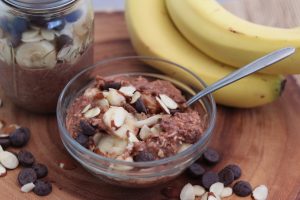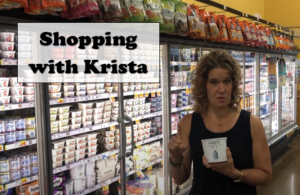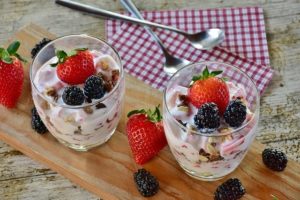 Do all of the choices in the yogurt section of the grocery store overwhelm you?
Do all of the choices in the yogurt section of the grocery store overwhelm you?
We can relate!
And, we want to share what we have learned on our REAL food journey.
There are so many options…traditional, Greek, Icelandic, Australian, fruit flavored, fruit on the bottom, low-fat, non-fat, soy, almond, coconut, sweet and crunchy…with over 100 varieties sold in many grocery stores (all claiming to be great for you), no wonder it’s so intimidating!
The good news is that yogurt is actually fairly simple! Plus, it can be super-healthy…it is loaded with protein, a great source of calcium, and is packed with beneficial bacteria that promote healthy digestive and immune systems.
Check out our latest Grocery Store Tour for a trip to the yogurt section!
As we mentioned in the video, there are only three ingredients required to make yogurt – milk and two live active cultures (Lactobacillus bulgaricus and Streptococcus thermophilus). These active cultures are what convert the milk to yogurt during the fermentation process — and are the beneficial bacteria we need to maintain a healthy gut!
Some common types of yogurt you will find in the store include:
Traditional yogurt: this yogurt is unstrained and tends to be thinner because it has more liquid.
Greek yogurt: this yogurt is strained, removing some of the liquid and creating a thicker texture. Typically, 3 cups of milk is used to produce 1 cup of Greek yogurt. Because some of the whey is removed, it tends to be lower in carbs and sugar – and higher in protein – compared to traditional yogurt. Some people think it has a more sour or tart taste compared to traditional yogurt. Buyer beware: some “Greek yogurts” are produced with added thickeners and protein (vs. being strained)…we recommend staying away from these varieties, and you will find them by reading those ingredient labels!
 Icelandic yogurt (also called “skyr”): this yogurt is strained even more than Greek yogurt, typically using 4 cups of milk to produce 1 cup of yogurt. For this reason, it tends to be even thicker – and has even more protein – than Greek yogurt. Skim milk is typically used as the base, although you can also find varieties that use milks with a higher fat content. A couple of popular brands include Siggi’s and Icelandic Provisions.
Icelandic yogurt (also called “skyr”): this yogurt is strained even more than Greek yogurt, typically using 4 cups of milk to produce 1 cup of yogurt. For this reason, it tends to be even thicker – and has even more protein – than Greek yogurt. Skim milk is typically used as the base, although you can also find varieties that use milks with a higher fat content. A couple of popular brands include Siggi’s and Icelandic Provisions.
Australian yogurt: like traditional yogurt, it is typically unstrained. However, because it is usually made with whole milk, it tends to have a thicker and creamier consistency than the traditional variety (but it is generally not as thick as Greek or Icelandic yogurts). A couple more commonly found brands include Noosa and Wallaby.
Non-dairy yogurts (like soy, almond and coconut): because these are so thin, they often contain thickeners, sugars and other additives to make them more palatable for consumers. They also contain less protein than their dairy-based counterparts.
When you find yogurts that simply contain the primary ingredients (milk and live active cultures), they are the most nutritious.
You can then add your own fruit, nuts, seeds and other add-ins to transform them into some truly delicious snacks, breakfasts or treats.
Beware of Added Ingredients!
As we also mentioned in the video, many yogurts at the store have more ingredients than just the milk and live active cultures. As always, read those ingredient labels and be on the lookout for added sugars, thickeners and other additives.
- Even something as simple as vanilla yogurt can be loaded with added sugar. One popular brand of vanilla yogurt has 18 grams of added sugar (4.5 tsp) per serving!
 When they add fruit, they also add some form of sugar. If you are buying these, try to find one where the actual fruit comes before the sugar in the ingredient label. Beware…we ran across a strawberry yogurt that looked like it was healthy, but it had NO STRAWBERRIES in the ingredients (and it had almost 4 tsp of added sugar per serving).
When they add fruit, they also add some form of sugar. If you are buying these, try to find one where the actual fruit comes before the sugar in the ingredient label. Beware…we ran across a strawberry yogurt that looked like it was healthy, but it had NO STRAWBERRIES in the ingredients (and it had almost 4 tsp of added sugar per serving).
- It doesn’t take a rocket scientist to know that yogurts loaded with candy, cookies and “moose tracks” are not good for us. Instead, buy plain yogurt and add cacao nibs, dark chocolate chips, granola, nuts or other healthy add-ins.
- “Light” and “sugar-free” versions contain artificial sweeteners (like sucralose, aspartame and acesulfame-potassium) that, according to the Center for Science in the Public Interest, you should really try to avoid.
- Watch out for artificial colorings like Blue #1 and Red #40. (Sometimes, I guess those cherries need a little help to achieve the color the yogurt company is looking for?!)
- Thickeners are often added to achieve the desired consistency. Some of these thickeners are believed to cause digestive and other health issues for some people.
Zonya Says:
 Keep an eye out for next week’s coaching tip, where we will provide all kinds of great-tasting yogurt ideas…from sauces to dressings to pastas to salads to breakfasts and, of course, sweet treats! If you are looking for a couple of inspiring ideas in the meantime, check out the Chocolate Peanut Butter Overnight Oats or the Mexican Black Bean Veggie Pizza (which includes a flavor-loaded Avocado Cream).
Keep an eye out for next week’s coaching tip, where we will provide all kinds of great-tasting yogurt ideas…from sauces to dressings to pastas to salads to breakfasts and, of course, sweet treats! If you are looking for a couple of inspiring ideas in the meantime, check out the Chocolate Peanut Butter Overnight Oats or the Mexican Black Bean Veggie Pizza (which includes a flavor-loaded Avocado Cream).
Remember to keep reading those ingredient labels!
We hope our grocery store tours continue to be helpful!
What section would you like us to visit next?
Granola bars? Ice cream? Meats? The bread aisle? Please share with us!





Nice tour Krista! I wanted to also say that we buy ALMOST exclusively plain nonfat Greek Yogurt now, and doctor it up ourselves, as needed, each time. Going in whichever direction we want…vanilla or lemon extract, plus fruit, nuts and always…Ground Flax. But if you really want individual cups, already a little sweet, Try SIGGi’S. Smartly and nicely lightly sweet!
Love these tours- have you hit the butter/ new margarine section yet? That would be interesting. Best- Greg
Love these tours. They are so helpful! How else would we find out this important information? Thanks, and keep doing them.
Thank you, so happy you enjoy and appreciate them! Feel free to send us your ideas on what grocery store section you would like to see next!
Thanks, Krista, for another helpful grocery tour video! I’m happy to say the Greek strained nonfat yogurt that I’ve been using has only milk and cultures in it. Whew! 🙂 It’s the store brand under the name Open Nature. I’ve been hungry lately for a bowl of ice cream so I’d love your advice on what to look for and avoid with those choices.
We appreciate the tip on the next section to cover, thank you! We will get to working on that!
Great video. I am going to see if I can find Siggi’s in Canada. I had tried it when I lived in US and loved it. I also don’t think we have Chobani in Canada. I will have a look. What is the name of your grocery store? It sure has a huge selections of yogurt.
We really like the Siggi’s plain yogurt. Our local store is Dillon’s, which is owned by Kroger. They do have a large selection of yogurts, although many of them have a lot of added sugars, thickeners and other ingredients. We love buying plain yogurt (just milk and live active cultures), and then transforming it into all kinds of sauces, dressings, salads, breakfasts, sweet treats and more. Stay tuned…more on this coming on Tuesday!
I love the tours!! Great information!! Thanks.